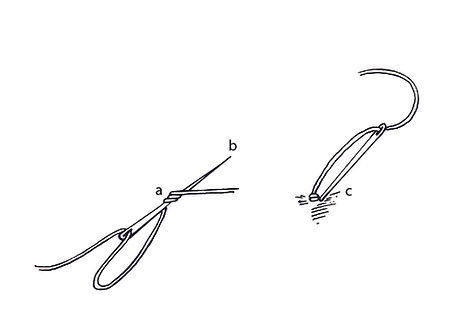HEAL THE INDUSTRY
by showcasing the possibilities of upcycling with brands, shops, corporate, green groups and artists.

Make a Knot
A knot can be the end of a needlework or a dot in an embroidery.
1. Hold the needle on the knot's position,,
2. Wrap the thread around it twice.
3. Press the spot with your thumb UNTIL
the thread is pulled out and the knot is tightened.
4. Stitch down at the same spot.
5. Continue with the next stitch.
Running Stitch
From the knot to knot, let’s do it right from zero.
This is the origin of embroidery culture, such as Kantha from India, Boro and Sashiko from Japan.
It is used in hand-sewing and tailoring to sew basic seams, in hand patchwork to assemble pieces, I suggest 3-4mm width per stitch.
For example:
1. Patchwork
2. Edge finishing, normally 1 cm for the seam allowance
3. Combining fabric panels
However, if you want to strongly and permanently attach two pieces of fabric, you have to use back stitch.


Back Stitch
Back stitch is a class of embroidery and sewing stitches.
1. In hand sewing, it is a utility stitch which strongly and permanently attaches two pieces of fabric.
2. In embroidery, these stitches form lines and are most often used to outline shapes and details.
3. It is also used to embroider lettering.
Hidden Stitch
Hidden or blind stitching hides stitching under folded edges. It is a method of joining two pieces of fabric so that the stitch thread is invisible.
-
Best use for directly attaching pieces of fabric on the outside.
-
Blind hem stitches are almost completely hidden on both sides of the garments. (Turn inwards as the picture of running stitch) To be completely hidden on the front of the garment, each time the needle is pulled through only a 2-3 threads of the fabric, which means that the majority of the stitching is hidden inside the hem.


Cover a Button
Leaving 3mm for seam allowance, apply running stitches along
a piece of circle fabric that is cut in bias.
Pull the thread tight and end up with a knot.
Cover the old buttons with the fabric you like. The diameter is about twice the diameter of the button plus its height.
*Wrapping the button with a piece of wet fabric
could get a better effect for the non-stretched fabric.
Handworked Buttonhole
It is convenient to use machine, but the perfection of a handworked buttonhole is something else. It’s an irreplaceable beauty.
Hand-sewn buttonholes require that the slit is carefully cut first, after which a dense blanket stitch is applied to clean finish its raw edges.
You can also apply blanket stitch to reinforce or decorate any kind of edges.


Darning Stitch
Recently there’s been a renaissance around “visible mending’.
Darning is usually applied on the knees, socks, jeans and jumpers.....Visible mending allows it to become part of the history of a cherished garment, with the stitching done in contrasting colours rather than merely being sewn in matching threads
to pretend nothing happened.
Darning stitch is a simple running stitch in which the thread is "woven" in rows along the grain of the fabric, with the stitching reversing direction at the end of each row, and then filling in the framework thus created, as if weaving.
Extending the running stitches outside the damaged area helps holding the lines straight and tight.
Needle Felting
Needle felting is a super quick and easy method of repairing holes in knitwear or fabric.
Grab a needle felting tool plus a mat, spread the wool felt evenly, then start to stab away. Carefully adjust the shape and the thickness, and finally clean finish the edge.
Watch out for the needle, don't put your finger too close to it!


Fly Stitch
Fly stitch or Y stitch looks like a little fly or ‘Y’. Horizontal or vertical rows of fly stitch can be done to create various effects.
I particularly like to embroider rows of fly stitches that bring me the smell of fern.
To work a single fly stitch, bring the needle up through the fabric from point (a) and down a short distance away at point (b),
leave a loop on the surface and
bring the needle up again at point (c),
then one stitch forward to complete the Y.
Chain Stitch
Chain stitch is a sewing and embroidery technique in which a series of looped stitches form a chain-like pattern.
Especially for the vintage lovers, the hem at the leg opening should be a chain stitch, which develops the desired roping effect after washing because the hem twists around itself due to the inconsistent shrinkage between the fabric and the stitches.


Sashiko - Gushizashi
Sashiko (Japanese: 刺し子, literally "little stabs" or "little pierce") is a form of decorative reinforcement stitching from Japan that started out of practical need during the Edo era (1615-1868).
Sashiko is a variable combination of running-stitching. It was traditionally used to reinforce the wear point or repair the worn or torn with patches. Overlapping layers of fabric made the clothing stronger and warmer.
Sashiko - Jujiizashi
Sashiko (Japanese: 刺し子, literally "little stabs" or "little pierce") is a form of decorative reinforcement stitching from Japan that started out of practical need during the Edo era (1615-1868).
Sashiko is a variable combination of running-stitching. It was traditionally used to reinforce the wear point or repair the worn or torn with patches. Overlapping layers of fabric made the clothing stronger and warmer.


Sashiko - Yamazashi
Sashiko (Japanese: 刺し子, literally "little stabs" or "little pierce") is a form of decorative reinforcement stitching from Japan that started out of practical need during the Edo era (1615-1868).
Sashiko is a variety of running-stitch combinations. It was traditionally used to reinforce the wear point or repair the worn or torn with patches. Overlapping layers of fabric made the clothing stronger and warmer.
